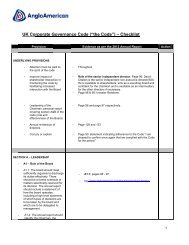Download PDF - Kumba Iron Ore
Download PDF - Kumba Iron Ore
Download PDF - Kumba Iron Ore
Create successful ePaper yourself
Turn your PDF publications into a flip-book with our unique Google optimized e-Paper software.
GROUP – NOTES TO THE ANNUAL FINANCIAL STATEMENTS<br />
FOR THE YEAR ENDED 31 DECEMBER<br />
29. FINANCIAL INSTRUMENTS continued<br />
Sensitivity analysis<br />
A movement in exchange rates of 5%, with all other variables held constant, against the US dollar would have increased/(decreased) profit or<br />
loss and equity by the amounts shown below.<br />
The impact on equity includes the after-tax impact of the movements in profit or loss. The analysis has been performed on the basis of the<br />
change occurring at the start of the reporting period and is performed on the same basis for 2010.<br />
This analysis considers the impact of changes in foreign exchange rates on profit or loss and equity, excluding foreign exchange translation<br />
differences resulting from the translation of group entities that have a functional currency different from the presentation currency, into the<br />
group’s presentation currency (and recognised in the foreign currency translation reserve).<br />
Impact on profit or loss Impact on equity<br />
Rand million<br />
Increase Decrease Increase Decrease<br />
2011<br />
US dollar 91 (91) 66 (66)<br />
2010<br />
US dollar 58 (58) 42 (42)<br />
Interest rate risk<br />
Interest rate risk arises from the group’s floating rate borrowings and the floating rate cash balances which exist. The company is not exposed to fair<br />
value interest rate risk as the company does not have any fixed interest bearing financial instruments carried at fair value. As part of the process of<br />
managing the company’s interest rate risk, interest rate characteristics of new borrowings and the refinancing of existing borrowings are positioned<br />
according to expected movements in interest rates. For further details on long-term borrowings refer to note 9 ‘Interest-bearing borrowings’.<br />
Sensitivity analysis<br />
Changes in market interest rates affect the interest income or expense of floating rate financial instruments. A change in the market interest rate<br />
of 50 basis points, with all other variables held constant, would have increased/(decreased) profit or loss and equity by the amounts shown below.<br />
The impact on equity includes the after-tax impact of the movements in profit or loss. The analysis has been performed on the basis of the<br />
change occurring at the start of the reporting period and is performed on the same basis for 2010.<br />
Impact on profit or loss Impact on equity<br />
Rand million<br />
Increase Decrease Increase Decrease<br />
2011<br />
Floating interest rate instruments (8) 8 (6) 6<br />
2010<br />
Floating interest rate instruments (8) 8 (6) 6<br />
Price risk<br />
The group is not exposed to commodity price risk, as the value of its financial assets or liabilities are not subject to commodity price movements.<br />
The group is exposed to equity securities price risk from equity investments held by the environmental trust. Refer to note 4 ‘Investments held by<br />
environmental trust’.<br />
Fair value<br />
The fair values of cash and cash equivalents, trade and other receivables and trade and other payables approximate the respective carrying<br />
amounts of these financial assets and financial liabilities because of the short period to maturity of these instruments. The fair value of interestbearing<br />
borrowings is disclosed in note 9.<br />
Level 1 1 Level 2 2 Level 3 3<br />
Fair value measurements recognised in the consolidated balance sheet<br />
2011<br />
Investments held by the environmental trust (refer to note 4) 283 – –<br />
Derivative financial assets 90 – –<br />
Derivative financial liabilities (14) – –<br />
359 – –<br />
2010<br />
Investments held by the environmental trust (refer to note 4) – 71 –<br />
Derivative financial assets 78 – –<br />
Derivative financial liabilities (30) – –<br />
48 71 –<br />
1 Level 1 fair value measurements are derived from unadjusted quoted prices in active markets for identical assets or liabilities.<br />
2 Level 2 fair value measurements are derived from inputs other than quoted prices included within level 1 that are observable either directly or indirectly (i.e. derived from prices).<br />
3 Level 3 fair value measurements are derived from valuation techniques that include inputs that are not based on observable market data.<br />
There were no transfers between level 1 and level 2 during the year. This was also the case in 2010.<br />
62 <strong>Kumba</strong> <strong>Iron</strong> <strong>Ore</strong> Limited



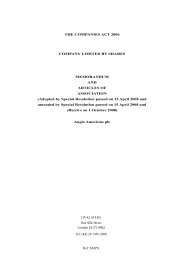
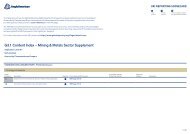
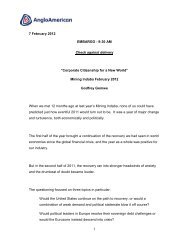
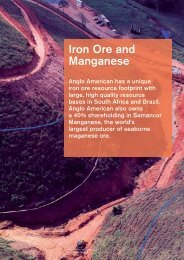
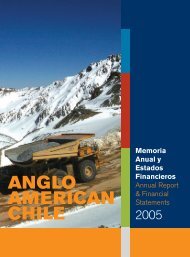
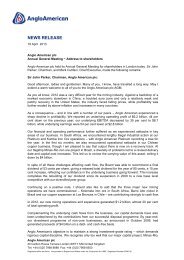
![English PDF [ 189KB ] - Anglo American](https://img.yumpu.com/50470814/1/184x260/english-pdf-189kb-anglo-american.jpg?quality=85)




![pdf [ 595KB ] - Anglo American](https://img.yumpu.com/49420483/1/184x260/pdf-595kb-anglo-american.jpg?quality=85)
![pdf [ 1.1MB ] - Anglo American](https://img.yumpu.com/49057963/1/190x240/pdf-11mb-anglo-american.jpg?quality=85)
